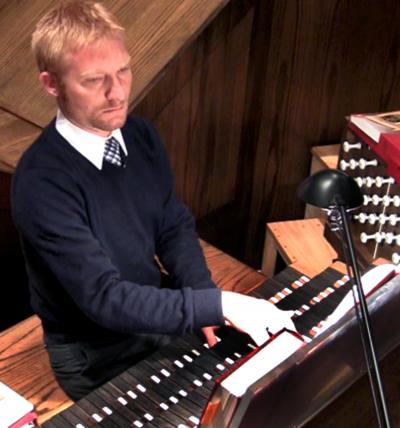NMSU Extension natural resource agent enjoys second vocation as organist

The Bernalillo County Cooperative Extension Service agent plays a three-tiered keyboard of an organ console, known in the organ world as a three-manual organ. With well-trained fingers and feet, Garlisch brings forth music as pressurized air flows through pipes varying in size and sound. His calendar is filled with playing engagements as a substitute church organist.
"Playing music is a nice break from my work as a 4-H and natural resource Extension agent," he said. "It can be enjoyable and stressful at the same time. As a member of the American Guild of Organists, I get called upon to play for churches as needed. I am at a different church each Sunday, and I also accompany adult and school choirs as requested."
Garlisch gave his first official recital in Albuquerque in December at the Cathedral of St. John Episcopal in downtown Albuquerque. He played "Wachet Auf" or "Sleepers Awake" by J.S. Bach; "Choral Prelude on 'In Dulci Jubilo'" by Buxtehude; and "Organ Toccata on 'Veni Emmanuel'" by Andrew Carter.
Raised in a family of musicians where his aunt, great-aunt and great-grandmothers were organists, Garlisch comes by his musical talent naturally.
"Our family has a photograph of me at three years old sitting on my aunt's lap attempting to play the piano. My parents took that as a good sign and I started piano lessons when I was 6," said the native of a small farming community, Allens Grove, in Illinois. "I took an interest in the organ around 11 or 12 years old and began taking lessons from my piano teacher, Patricia Eigenbrod."
One Wednesday evening prior to a church service, the teenage Garlisch's future was cast. "The church organist called in sick. The pastor knew I was taking piano lessons. He came to me and said, 'John, do your memory work, because you are going to play for church tonight.' That was the beginning of my being a church organist."
As a senior in high school while pondering his college education, Garlisch had to decide between a career in music or horticulture, both of which he was equally passionate about.
"Mrs. Eigenbrod gave great insight to my decision. She encouraged me to get a degree in horticulture, but to keep playing music throughout my life. She said that way one could earn a living, pay bills and play for the enjoyment, too," Garlisch said of his music mentor who was also a 4-H leader, farmer's wife, choir director and church organist.
"I decided to major in horticulture from the University of Illinois at Urbana-Champaign to be able to earn a decent living, because musicians don't make that much of a wage."
While working on his bachelor of science in horticulture and master's in agriculture and consumer economics, Garlisch continued his organ studies for liberal arts credits and held a permanent part-time position, playing organ at a church in Urbana.
"I enjoy the challenge of employing multiple senses and skills while playing the organ," he said. "I get to play two to three keyboards, called manuals, with both hands, and one bass keyboard with my feet. The organ has multiple voices and it is a challenge to make the organ sing. Besides the technique of playing being challenging, it is also a great mental stimulation."
One of the challenges of playing the organ is that the large size of the instrument and the placement of the pipes can lead to a lag from when the keys are played to when the sound reaches the organist's ears.
"If pipes are behind you and in front of you, they each speak at differing times," he said. "The challenge for the organist is to have the notes sound at the right time. Some buildings have a three second or longer delay from when the organist presses the keys to when the sound is audible."
Garlisch plays a broad spectrum of music. He keeps discovering and re-discovering musical pieces all the time because, he says, a piece of music can take on new life when played on a different instrument and in a different setting.
"For organ I enjoy playing the music of Bach, Buxtehude and Mendelssohn, and I have a growing appreciation of Hindemith," he said. "For piano, I enjoy Beethoven, Chopin, Rachmaninoff and Prokofiev."
He has a strong German music background developed while growing up and taking lessons in college.
"I play a broad spectrum of music," he said. "All depends on the repertoire my teacher gives me, as well as the congregation I play for. I play some baroque, romantic, classical, modern and contemporary pieces and composers."
Since joining NMSU's faculty and moving to Albuquerque in 2010, Garlisch has continued his lessons with Maxine Thevenot, director of cathedral music and cathedral organist at the Cathedral Church of St. John's, an Episcopal Church in Albuquerque.
"Dr. Thevenot has a distinguished international career and has performed throughout Europe, Great Britain and North America at many prestigious churches, concert halls and festivals. It is an honor to study from her," Garlisch said. "She is challenging me with more French, French-Canadian and modern composers' repertoire."
To ask about his favorite musical piece is like asking a father which one of his children is his favorite.
"My musical tastes have changed over time with pieces I have played and listened to," he said. "I don't have one particular piece that is my favorite, but I enjoy listening to well-played music."
To learn more about the pipe organ visit http://www.youtube.com/watch?v=sHU63VU7aCY where Garlisch demonstrates the many voices of the instrument.


